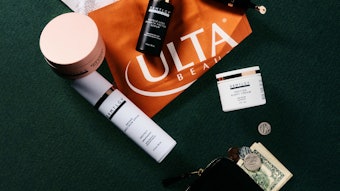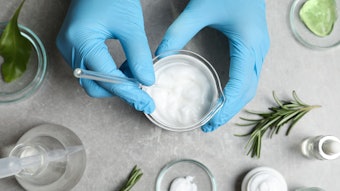
Polydeoxyribonucleotide (PDRN) has starred in numerous recent beauty headlines. In early August, for example, Harper's Bazaar India highlighted it1 as the latest K-beauty hero ingredient "transforming hydration, healing and anti-aging." Around the same time, a writer for Marie Claire reported her experience of receiving 700 injections of it across her face.2 The result? A "shockingly glass-like glow."
The future for PDRN, according to Taub, is more research. "Many people are injecting it ... and expecting a transformation. I think it will be an adjunct but it isn't a proven entity by itself." Taub added that injection is not an approved use in the U.S., so the company only uses it topically on the skin surface — for now.
This article is only available to registered users.
Log In to View the Full Article
Polydeoxyribonucleotide (PDRN) has starred in numerous recent beauty headlines. In early August, for example, Harper's Bazaar India highlighted it1 as the latest K-beauty hero ingredient "transforming hydration, healing and anti-aging." Around the same time, a writer for Marie Claire reported her experience of receiving 700 injections of it across her face.2 The result? A "shockingly glass-like glow."
An academic study published in April reported PDRN's tissue-regenerative and anti-inflammatory benefits for periodontal disease.3 In fact, across all sources, from June 16 - August 14, the total search volume for PDRN grew by 14% to reach 277K, according to internal web and social media monitoring.
There are many others but these examples alone warrant a deeper dive into why beauty consumers love PDRN and what makes it so great — so we dove. Industry experts Mindy Goldstein, Ph.D., Michelle Shieh and Amy Taub, M.D., took the plunge with us.
PDRN: A Fragmented DNA Mix
PDRN is a nucleic acid mix4 of DNA fragments with molecular weights5 typically spanning between 50 and 1,500 kDa,6 although some research suggests fragments as small as 1 kDa and as large as 10,000 kDa.
It is traditionally extracted and refined from the sperm cells of chum salmon (Oncorhynchus keta) or trout (Oncorhynchus mykiss). As Squadrito, et al., explained in Frontiers,7 "the source of raw material ... is of particular importance: spermatozoa are the most appropriate cells to provide highly purified DNA without risk of impurity such as peptides, proteins and lipids which can remain from the somatic cells."
 Various sources have reported that PDRN has a composition similar to that of human DNA, enabling some functional similarities and improving the body's tolerance to it.Image by Ekkasit A Siam at Adobe Stock
Various sources have reported that PDRN has a composition similar to that of human DNA, enabling some functional similarities and improving the body's tolerance to it.Image by Ekkasit A Siam at Adobe Stock
Various sources have reported that PDRN has a composition similar to that of human DNA,8 enabling some functional similarities and improving the body's tolerance to it. Squadrito, et al., added that the material is extracted and purified "at a high temperature to recover a >95% pure active substance with inactivated proteins and peptides to ensure the safety of the product and lack of immunological side effects."
Industry expert Mindy Goldstein, Ph.D., provided a deeper explanation. "PDRN is basically a low molecular weight fraction of DNA, with molecular weights between 50 and 1500 KDa and a chain length ranging from 50 base pairs to 2,000 base pairs, which has been typically sourced from salmon sperm." She also confirmed it was found to share similarities to DNA found in human placenta.
"DNA and RNA have been used in cosmetics for many years," she continued. "Years ago, we used it in sunscreen formulations as a decoy molecule that would help reduce cellular DNA damage by giving the UV radiation a target outside of the cellular nucleus." She added that at that time, there was no research into other biological effects of using DNA or RNA in products.
PDRN's Demonstrated Skin Benefits
"More recent research has demonstrated that PDRN has anti-inflammatory and wound-healing properties, as well as the ability to synthesize collagen and reduce hyperpigmentation," wrote Goldstein.
Indeed, numerous studies have demonstrated the benefits of PDRN for skin care, making it a major draw for dermatological and topical skin care innovators. Those on the cusp of industry trends have undoubtedly heard of salmon facials or salmon sperm for skin, for example. "It has become very popular in Korean skin care," Goldstein highlighted.
Michelle Shieh, senior manager of scientific communications for AmorePacific, added, "PDRN has been a popular in-office treatment in Korean beauty for its skin-rejuvenating benefits. The in-office treatment involves painful injections, is expensive and requires ongoing maintenance but gained recognition for its benefits on promoting skin renewal, elasticity and overall skin rejuvenation."
Shieh continued, "This trend has since evolved into the skin care space- PDRN ingredients are now incorporated into skin care formulas, offering comparable benefits in a more accessible and user-friendly format. PDRN serums deliver daily skin support without discomfort, making them a compelling alternative for U.S. consumers seeking effective, non-invasive skin care solutions."
Khan, et al.,9 among others, have described PDRN's benefits, ranging from anti-inflammatory, anti-apoptotic and anti-melanogenetic, to tissue damage preventative, collagen synthesis boosting, angiogenesis-promoting, wound healing and more.
"It works through the activation of the A2A adenosine and salvage pathway, which plays roles in inflammation control, cell proliferation and collagen production," Goldstein explained. "It has been shown that activation of the adenosine A2A receptor reduces inflammatory infiltration; promotes endothelial cell proliferation and migration, and VEGF production; and stimulates fibroblast differentiation and maturation, consequently accelerating the repair process."
According to Goldstein, most serums that are sold using PDRN are used by estheticians or spas with microneedling or lasering to help it penetrate the skin.
"PDRN excels in wound healing and deep tissue repair," Goldstein emphasized. "Clinical studies show that it accelerates healing post-injury or procedure and effectively supports collagen remodeling and scar reduction. This makes PDRN particularly valuable for damaged, compromised or sensitive skin, and as after-care post-laser, microneedling or for chronic wounds."
PDRN Sourcing and Examples
As noted, salmon sperm DNA remains the predominant source of PDRN. "It is extracted and extensively purified from the salmon sperm," Goldstein detailed. "The seminal fluid (sperm) is collected from salmon or other fish. The sperm cells are lysed using a buffer solution containing detergents and proteolytic enzymes to digest proteins and release the DNA.
"The DNA is further purified by separation from the proteins through different precipitations and filtrations," she continued. "Most likely, it is cleaved by physical mechanisms such as sonication or controlled hydrolysis. PDRN generates nucleotides and nucleosides that can contribute to DNA formation, reactivating normal cell proliferation and growth pattern."
In addition to salmon DNA, alternative sources are gaining attention. Following are a few examples.
 Salmon or trout are the most common source for PDRN, which is widely used in pharmaceutical and aesthetic products like the Rejuran K-beauty brand.Image by charnsitr at Adobe Stock
Salmon or trout are the most common source for PDRN, which is widely used in pharmaceutical and aesthetic products like the Rejuran K-beauty brand.Image by charnsitr at Adobe Stock
Aquatic animals: As stated, salmon or trout are the most common source for PDRN. This type is widely used in pharmaceuticals and aesthetics; examples of brands include Placentex, Rejuran and Mesocel.
Terrestrial plants: Plant-derived PDRN, sourced from nucleic acids in botanicals like ginseng or soybean, mimics the structure and function of marine PDRN while offering vegan-friendly positioning. It is currently found in cosmetic serums and essences, particularly in K-beauty markets. Commercial examples include the VT Cosmetics PDRN 100 Essence, Innisfree Green Tea PDRN Ampoule and Eqqual Berry Purple PDRN.
Microbes: Microbial-derived PDRN is produced via recombinant bacteria or yeast. While it is still largely in the research stage, it has strong potential for sustainable and vegan-certified applications. One example was recently described in Molecular Biology: microbial-derived PDRN (L-PDRN) extracted from Lactobacillus rhamnosus.10
According to the authors, the L-PDRN exhibits superior antioxidant activity, enhanced wound-healing capabilities, and improved immunomodulatory effects compared to traditional salmon-derived PDRN.
Blue PDRN from microalgae: Another innovative example of sourcing comes from Amorepacific. Researchers there explored a marine plant-based route: extracting PDRN from microalgae, which it accomplished as part of a national initiative led by South Korea’s Ministry of Oceans and Fisheries.
"The development of BluePDRN (derived from microalgae) reflects AmorePacific’s strategic commitment to sustainability and ethical innovation," Shieh explained. "While salmon-derived PDRNs are effective, they present ecological and scalability challenges. In contrast, microalgae provide a vegan alternative with comparable efficacies. This ingredient is currently exclusive to Amorepacific."
According to the researchers, the blue PDRN demonstrated wound-healing effects equivalent to conventional salmon-based versions and its molecules were approximately 1/20th the size of their salmon-derived counterparts. These smaller compounds were said to boost collagen production and angiogenesis, acting through the same A2A receptor.
In addition to BluePDRN, AmorePacific has dipped into green tea to source PDRN. "Amorepacific recently launched a few products in the U.S. market with a PDRN ingredient derived from green tea," wrote Shieh. "This ingredient has been tested to show regenerative efficacy superior to that of salmon-derived PDRN.
"We plan to pursue further related research/develop highly effective vegan alternatives to PDRN, and expand the application of PDRN ingredients across our brand portfolio," she added.
PDRN: Formulating and Regulatory Considerations
In terms of formulating, Goldstein highlights some stability considerations of PDRN. "PDRN, being a nucleotide-based ingredient, is prone to degradation (hydrolysis or enzymatic breakdown) when exposed to heat, light and some pH conditions." She noted that skin care formulations must stabilize PDRN, often by controlling pH, using antioxidants or encapsulating the DNA fragments to prevent loss of activity during storage and use.
"There is ongoing development in novel delivery systems such as hydrogels and microspheres to enhance PDRN’s efficacy and reduce side effects," Goldstein reassured. She added that combination therapies are also being investigated that pair PDRN with other bioactive molecules like growth factors to create synergistic anti-aging and restorative effects.
"Beyond skin care and wound healing, PDRN is being explored for broader tissue engineering applications, including neuromuscular tissues, bone regeneration and ophthalmology," Goldstein noted.
In terms of regulatory constraints, Goldstein believes the cosmetics industry should be in the clear. "I don’t believe that there are any issues for cosmetics skin care," she wrote. "but the challenges will be greater for pharmaceutical and medical device uses. This may vary regionally."
New PDRN Ingredient Launches
In terms of recent cosmetic ingredient launches in this space, suppliers are taking different approaches to offer PDRN ingredients with improved sustainability and efficacy for skin care.
Biomacromolecule control: Kalichem launched its Kaligen biotech and plant-based PDRN sourced nucleobiotics during In-cosmetics global. According to the company, the production process is designed to create a carefully selected pattern of biomacromolecules to ensure high physio-compatibility and targeted skin-smoothing and rejuvenating effects across multiple skin layers.
Ultra-low molecularization: Similarly, PureGreen PDRN, from GFC Life Science Co., Ltd., is a PDRN derived from heartleaf (Houttuynia cordata) through an ultra-low (50 bp to 300 bp) molecularization technology for increased skin delivery to impart skin regeneration and anti-inflammatory effects.
Customizable plant sources: Presperse debuted a bio-based PDRN series at NY SCC Suppliers' Day: Cica-PDRN, extracted from Centella asiatica, and Lacto-PDRN, Lactobacillus plantarum, extracted from ginseng root. The ingredients are said to provide skin regeneration, anti-inflammation and moisturizing effects. In addition, the company offers customizable PDRN from other plant, flower and seaweed sources.
Fermented and botanical innovations: Additional fermented and botanical PDRN solutions highlighted at In-cosmetics global this year included:
- Lacto-PDRN by NFC Corp. — touted as the world’s first Lactobacillus-fermented PDRN for next-level skin regeneration;
- Damask Rose PDRN and the related Vegan PRN, by OptBio — described, respectively, as a premium skin care ingredient extracted from Damask roses, and a pharmacologically active RNA polymer derived from OPT-Y157, a Saccharomyces cerevisiae strain isolated from white truffle yeast; and
- AIO Marine Plant PDRN, by Rawmap Co., Ltd. — reported as the first vegan-certified PDRN from marine plants that reportedly has a smaller molecular weight and superior anti-inflammation, collagen synthesis and skin barrier enhancement efficacy over salmon PDRN.
PDRN Penetrates Hair Care
 Why hair care? Hair loss is caused by many things but inflammation and loss of microcirculation are key components. So adding PDRN "was a simple consideration." Image courtesy of KeraFactor
Why hair care? Hair loss is caused by many things but inflammation and loss of microcirculation are key components. So adding PDRN "was a simple consideration." Image courtesy of KeraFactor
In recent years, both the industry and consumers have experienced the skinification of hair phenomenon — and PDRN fits the bill. Recently, KeraFactor introduced PDRN into brow and lash serums, as well as the KeraFactor MD scalp treatment, to provide "optimal conditions for regrowth, especially after procedures like microneedling or platelet-rich plasma (PRP) therapy," per the company.
"PDRN are small fragments of DNA that act to repair cells, reduce inflammation and improve microcirculation," explained Amy Taub, M.D., board-certified dermatologist and co-founder of KeraFactor. "These are all excellent enhancements of the skin's ability to function normally — but whether it truly extends to 'regeneration' is more hype than proven science," Taub challenged.
So, why hair care? "Hair loss is caused by many things but inflammation and loss of microcirculation are key components," Taub detailed. "So adding PDRN to our already robust product, KeraFactor, was a simple consideration."
Touted benefits of the product for hair include:
- Enhanced blood flow: PDRN nourishes hair follicles by stimulating vascular activity.
- Inflammation reduction: It alleviates scalp inflammation, a common contributor to thinning hair.
- Growth activation: Dormant follicles are reactivated, promoting natural hair regrowth.
Importantly, KeraFactor also adds biomimetic and copper peptides to the PDRN for a more comprehensive solution. Taub noted, "using PDRN by itself without the other growth factors and peptides needed for hair growth would be a questionable strategy." Per the company:
- Biomimetic peptides: are incorporated to "mimic natural signals to stimulate follicle activity and
- Copper peptides: "strengthen strands and improve scalp health, acting like a 'fertilizer' for growth."
To formulate hair care products with PDRN, Taub shared KeraFactor's strategy. "In our products, we wrap each growth factor or peptide or DNA fragment individually in liposomes, ... the reason being that it is difficult to get anything absorbed into skin without it being fat soluble AND [to ensure that] they do not inactivate each other."
The future for PDRN, according to Taub, is more research. "Many people are injecting it ... and expecting a transformation. I think it will be an adjunct but it isn't a proven entity by itself." Taub added that injection is not an approved use in the U.S., so the company only uses it topically on the skin surface — for now.
PDRN's Next Chapter
As research on PDRN continues to advance, the next frontier will likely lie in smart delivery systems and combination therapies that maximize its restorative potential.
From nanocarriers and time-release microcapsules, to formulations paired with antioxidants and growth factors, innovators are exploring ways to make PDRN more effective and targeted.
References
1. Ganguly, A. (2025, Aug 6). PDRN (polydeoxyribonucleotide) is the new K beauty skin care ingredient in town and here's why we love it. Harper's Bazaar India. Available at https://tinyurl.com/2e5e7rdj.
2. Wu, S. (2025, Aug 6). I flew to Seoul to try salmon sperm injections for my skin. Marie Claire. Available at https://www.marieclaire.com/rejuran-salmon-sperm-injections-korean-skincare-review/.
3. Mari, R., Ramamurthy, J., Rudhra, K. and Krishnaswamy, N. (2025, Apr 9). Efficacy of polydeoxyribonucleic acid (PDRN) in periodontal regeneration: A systematic review of clinical outcomes. Available at https://pmc.ncbi.nlm.nih.gov/articles/PMC12008149/.
4. Akaberi, S.M., Sharma, K., Ahmadi-Ashtiani, H.R. and Hedayati, M. (2025, Apr 2). Polydeoxyribonucleotide in skin care and cosmetics: Mechanisms, therapeutic applications and advancements beyond wound healing and anti-aging. Journal of Skin and Stem Cell. Available at https://brieflands.com/articles/jssc-159728.
5. Hwang, K.-H., Kim, J.-H., Young Park, E. and Cha, S.-K. (2018, Oct 8). An effective range of polydeoxyribonucleotides is critical for wound healing quality. Molecular Medicine Reports, Spandidos Publications. Available at https://www.spandidos-publications.com/10.3892/mmr.2018.9539.
6. Oh, N., Hwang, J., Sung Kang, M. Yoo, C.-Y., Kwak, M. and Han, D.-W. (2025, Apr 14). Versatile and marvelous potentials of polydeoxyribonucleotide for tissue engineering and regeneration. Biomaterials Research. Available at https://pmc.ncbi.nlm.nih.gov/articles/PMC11994882/.
7. Squadrito, F., Bitto, A., ... Altavilla, D., et al. (2017, Apr 25). Pharmacological activity and clinical use of PDRN. Front Pharmacol. Frontiers. Available at https://www.frontiersin.org/journals/pharmacology/articles/10.3389/fphar.2017.00224/full.
8. Ra, H.J., Oh, M.Y., ... Jang, H.J., et al. (2018, Feb 23). Effects of salmon DNA fraction in vitro and in a monosodium iodoacetate-induced osteoarthritis rat model. The Korean Journal of Physiology and Pharmacology. Available at https://pmc.ncbi.nlm.nih.gov/articles/PMC5840075/.
9. Khan, A., Wang, G., ... Cui, H., et al. (2022, Dec). Polydeoxyribonucleotide: A promising skin anti-aging agent. Chinese Journal of Plastic and Reconstructive Surgery. Available at https://www.sciencedirect.com/science/article/pii/S2096691122000723.
10. Chae, D., Oh, S.-W., ... Seo, W.-S., et al. (2025, Jan 4). First report on microbial-derived polydeoxyribonucleotide: A sustainable and enhanced alternative to salmon-based polydeoxyribonucleotide. Current Issues in Molecular Biology. Available at https://www.mdpi.com/1467-3045/47/1/41.










